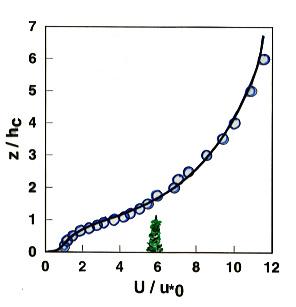 Numerical studies of wind flow in vegetation
Numerical studies of wind flow in vegetation Numerical studies of wind flow in vegetation
Numerical studies of wind flow in vegetationThe object of this (type of) study is to predict the turbulent flow through vegetation, on the basis of a few simple inputs: a physical description of the crop or forest, and values of windspeed (and more generally the temperature, humidity and net radiation) at some reference position above the canopy. Understanding canopy flow and turbulence is prerequisite to proper description of (eg.) deposition of harmful pollutants to a forest, variations in forest microclimate, or diagnosis of canopy evapotranspiration rate (water use).
In a canopy, long periods of relatively quiescent flow (light wind, small-scale mixing) are punctuated intermittently by strong downward "gusts" descending from the flow aloft, which "sweep out" the canopy air and replace it with (in the daytime) cooler, drier air. It has been shown that a large fraction of the total (say, hourly) exchange (of momentum, heat, vapour) between the canopy and the boundary-layer above occurs in a short fraction of the time, ie. during these sweeps. A consequence of this gusty nature is that, velocity statistics in a canopy are highly non-Gaussian.
From the fluid-mechanical point of view, the causal factor giving canopy flow its unique complexity is the fact that drag on plant parts extracts momentum and energy from the mean flow, and (equally importantly) from the turbulent eddies. That energy is deposited into energy of very small motions (wakes of individual leaves and stems), and rapidly dissipated by viscous friction. The consequence is that only a very short distance above canopy top, one measures a dramatic reduction (relative to just above the canopy) of windspeed and of the downward-travelling flux of momentum, as well as of the turbulent kinetic energy. In addition to being highly non-Gaussian, flow statistics in the canopy are strongly inhomogeneous in the vertical: these features of canopy flow raise a challenge for (a) numerical simulation of the flow itself; and (b), even given the flow statistics, the calculation of dispersion of heat, vapour, pollen, etc.
Back to the Earth & Atmospheric Sciences home page.